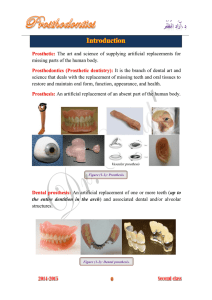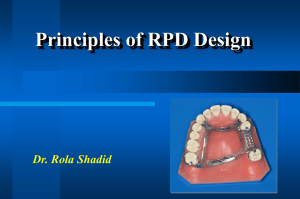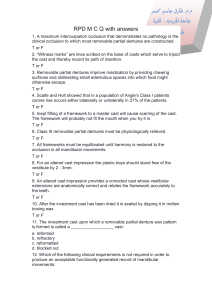• REFER TEXT BOOK : Mc. CRACKEN Dr. Praveen Srikantachary 15-02-2015
advertisement
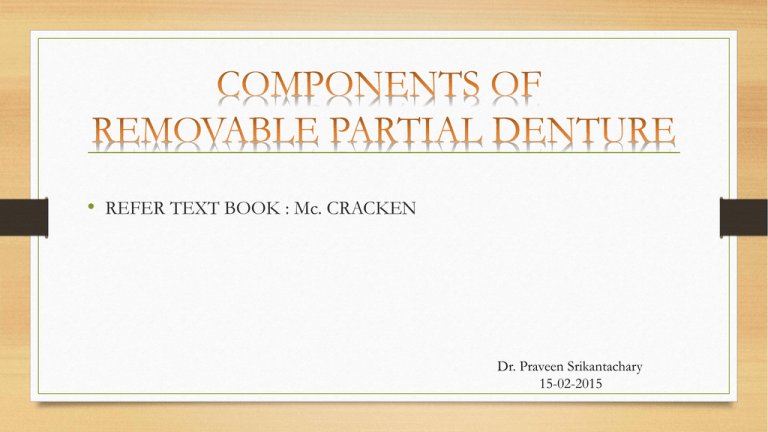
• REFER TEXT BOOK : Mc. CRACKEN Dr. Praveen Srikantachary 15-02-2015 Contents • Introduction • Classification of various components • Details of each components. INTRODUCTION • When using a prosthesis that can be removed from the mouth, the prosthesis must extend to both sides of the arch. This enables direction of functional forces to supporting teeth and tissue for optimum stability. • It is through this cross-arch tooth contact, which is at some distance from the functional force, that optimum resistance can be achieved. This is most effective when a rigid major connector joins the portion of the prosthesis receiving the function to selected regions throughout the arch Components of a typical RPD 1. Major connectors 2. Minor connectors 3. Rests 4. Direct retainers 5. Stabilizing or reciprocal components (as parts of a clasp assembly) 6. Indirect retainers (if the prosthesis has distal extension bases) 7. One or more bases, each supporting one to several replacement teeth Occlusal rest Major connector Direct retainer Minor connector Reciprocal arm MAJOR CONNECTOR • A major connector is the component of the partial denture that connects the parts of the prosthesis located on one side of the arch with those on the opposite side. • It is that unit of the partial denture to which all other parts are directly or indirectly attached. • This component also provides the cross-arch stability to help resist displacement by functional stresses Types of Major connector Maxillary Mandibular 1.Single posterior palatal bar. 1.Lingual bar, sublingual bar. 2.Palatal strap 2.Lingual plate. 3.Anteroposterior/Double Palatal bar. 3.CINGULAM bar. 4.Horse shoe shaped connector. 5.Closed horse shoe / anteroposterior palatal strap. 6.Complete palate 4.Labial bar. 5. Lingual bar with cingulam bar IDEAL REQUIREMENTS OF THE MAJOR CONNECTOR It should be rigid. Should provide vertical support (Maxilla), for the RPD. It should not impinge on free gingival margin and other soft tissues. Should provide indirect retention when needed (Mandible). The borders should parallel to the mean marginal gingival line and if any crossover it should be at right angle. Should enable to place the denture bases where required. Should not allow food lodgment beneath it. Should be comfortable to the patient. The borders should be as innocuous to the tongue as possible. Should be made with a material, which IS biocompatible. The borders are terminated in the valleys of the rugae. MINOR CONNECTORS • DEFINITION • A minor connector is defined as the connecting link between the major connector or base of a removable partial denture and other units of prosthesis such as clasps, indirect retainers and occlusal rests. GPT 8 TYPES 1. Minor connector that joins clasps assemblies to major connectors. 2. Minor connectors that joins indirect retainers or auxiliary rests to major connector. 3. Minor connectors that joins denture bases to major connectors. IDEAL REQUIREMENTS 1. must be RIGID- as they support active components of RPD 2. must have SUFFICIENT BULK to ensure rigidity 3. must be positioned so that they do not irritate the oral tissues. LOCATION Minor connectors located on proximal surfaces of teeth adjacent to edentulous areas should be broad buccolingually and thin mesiodistally RESTS: DEFINITION • A projection or attachment, usually on the side of an object –(GPT 8). • The components of a removable partial denture that serve primarily to transfer forces occurring against the prosthesis down the long axis of the abutment teeth are called rests. (- Stewart) • Any unit of a partial denture that rests on a tooth surface to provide vertical support is called rest. (McCracken’s) REST SEAT • The prepared recess in a tooth or restoration created to receive the occlusal, incisal, cingulum or lingual rests. (GPT 8) • The prepared surface of a tooth or fixed restoration into which a rest fits. (Stewart) CLASSIFICATION : I. a) Primary rest b) Secondary / Auxillary rest II. According to location : Anterior / Posterior III. According to surface : Occlusal IV. a) Intracoronal b) Extracoronal Incisal Lingual / cingulum Onlay Interproximal Internal DIRECT RETAINERS • DIRECT RETAINER- that component of a partial removable dental prosthesis used to retain or prevent dislodgement, consisting of a clasp assembly or precision attachment. (GPT 8) • The components of a removable partial denture that engage abutments and resist dislodging forces are called direct retainers (stewart). Components of a clasp assembly.. • • • • Retentive arm Reciprocal arm Rest One or more minor connectors Requirements of a clasp assembly • • • • • • Retention Support Stability Reciprocation Encirclement Passivity Classification • Retentive clasp assemblies 1. Circumferential or Aker’s or suprabulge 2. BAR type or vertical projection or infrabulge or Roach clasp INDIRECT RETAINERS • “ It is the part of RPD that assists the direct retainers in preventing displacement of distal exension denture bases by functioning through lever action on the opposite side of the fulcrum line ” FULCRUM LINE • It is an imaginary line passing through teeth and direct retainers, around which the denture rotates slightly when subjected to various forces directed toward or away from the residual ridges • More than one fulcrum line may be present for one RPD • Depends on direction and location of force TYPES OF INDIRECT RETAINERS • • • • • Auxillary Occlusal rest Canine extension from Occlusal rest Canine rest Continuous bar retainers & Linguoplates RUGAE support DENTURE BASES • The denture base supports the artificial teeth and consequently receives the functional forces from occlusion and transfers functional forces to supporting oral structures. • This function is most critical for the distal extension prosthesis, as functional stability and comfort often relate directly to the ability for this transfer offerees to occur without undue movement. • PROVIDE cosmetic effect of the replacement, particularly when techniques are used for tinting and reproducing natural-looking contours. • Adhesion and cohesion are effective when there is perfect apposition of the impression surface of the denture to the mucous membrane surfaces. These forces lose their effectiveness if any horizontal displacement of the dentures breaks the continuity of this contact. • Atmospheric pressure is effective primarily as a rescue force when extreme dislodging forces are applied to the denture. • It depends on a perfect border seal to keep the pressure applied on only one side of the denture.
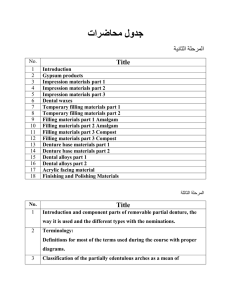
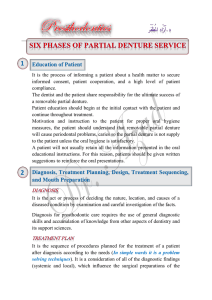
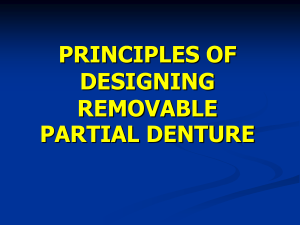
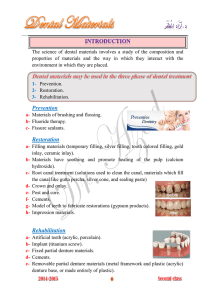
![other forms of removable partial denture [ppt]](http://s3.studylib.net/store/data/009527564_1-3147e0c80cfc579c21cbc7c629e44157-300x300.png)

